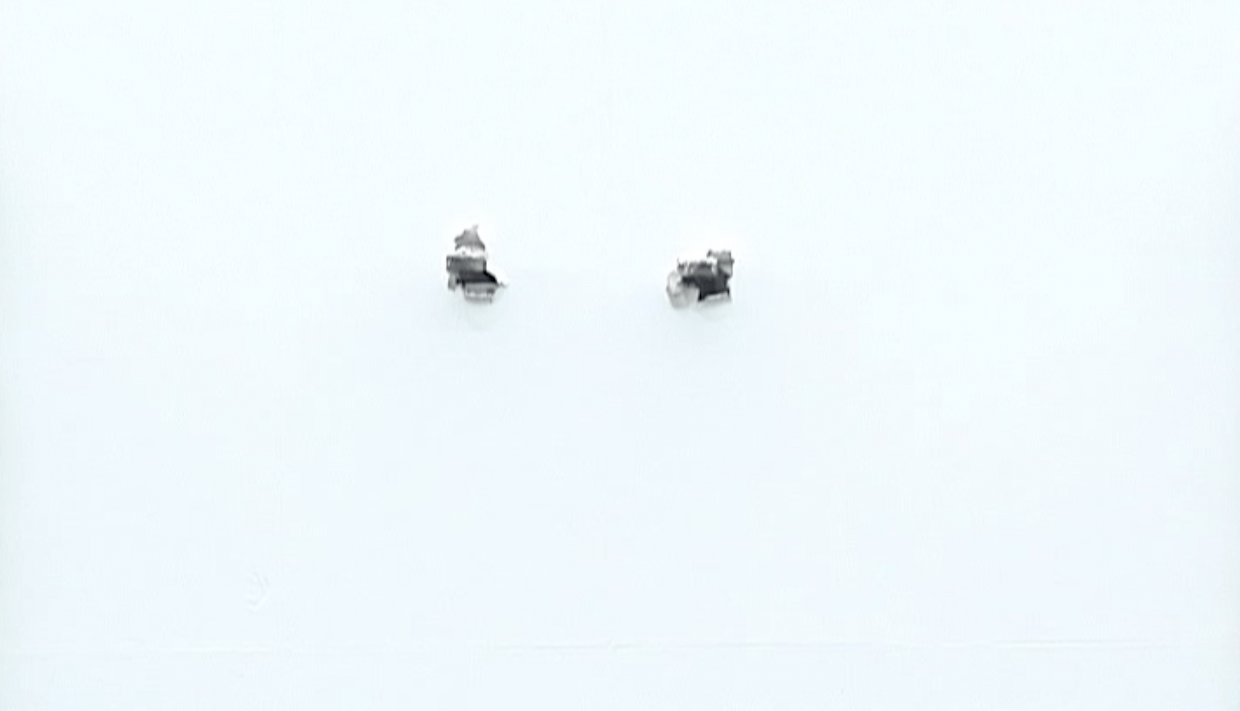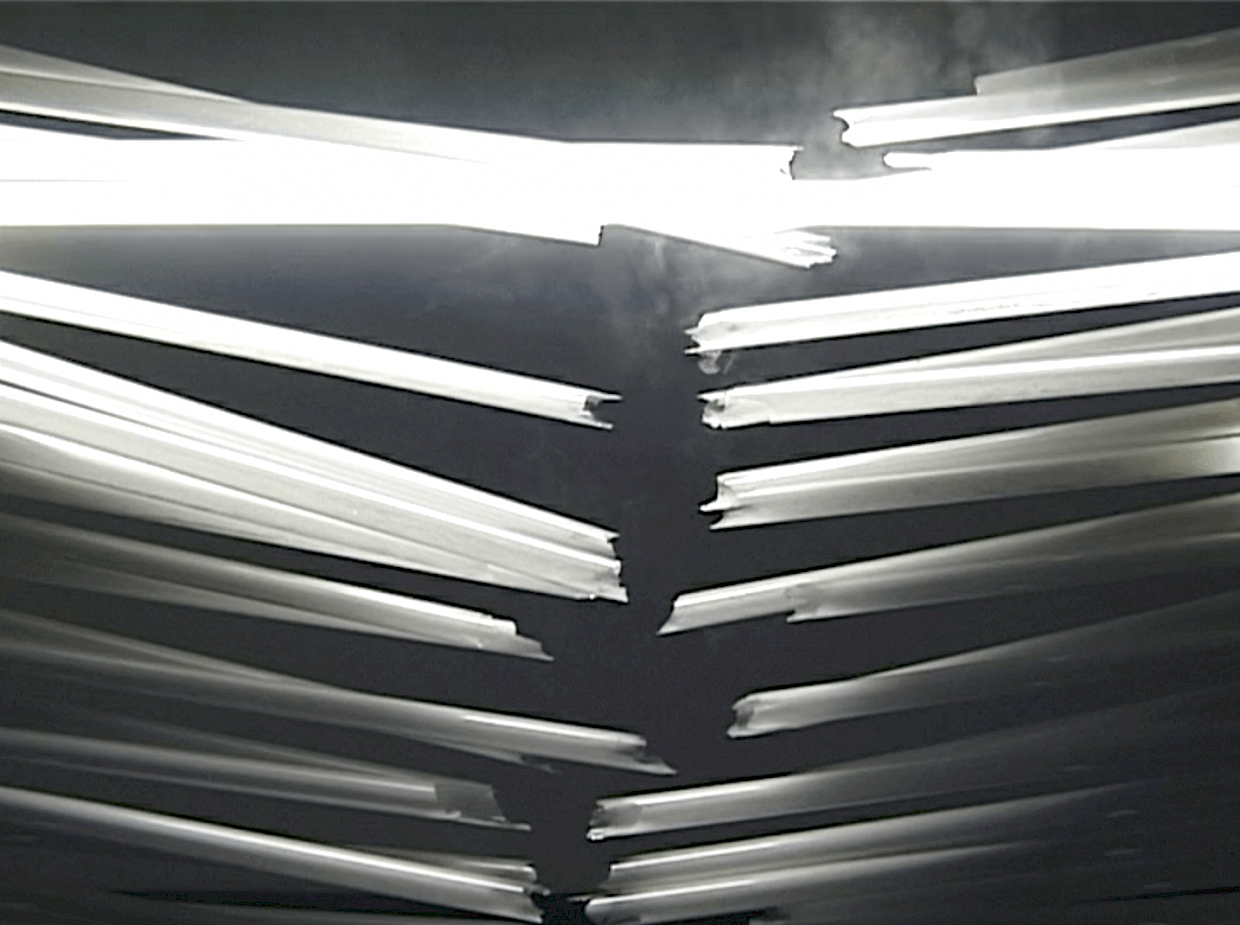

Matt Calderwood (b. 1975)
Screen

When collector Charles Saatchi bought a piece of rope made out of 50 toilet rolls for the controversial amount of EUR6.000 from Matt Calderwood and the artist was subsequently hired to produce a music video for British band The Streets, mainstream audiences became increasingly aware of Calderwood. From 1998 onwards, Calderwood – now primarily active as a sculptor – started making short videos centred on stunts he performed himself. The stunts undertaken by Calderwood are freakishly scary as much as they are funny. “Please don’t do this!” is how one British art critic summarised his thoughts about the videos.
Screen is something else altogether. No reckless stunts here. The video starts with an empty white wall, with the roaring sound of a heavy diesel engine in the background. Initially, it’s hard to tell what’s happening when two metal objects forcefully break through the wall. But as soon as the wall is lifted and driven away you get an inkling of what’s going on. By looking through the newly made hole in the wall, it now becomes possible to get a vague idea of what’s behind it. Now that the tractor is moving away, and more and more you start seeing the Northern Irish countryside dotted with stone walls – these are the surroundings of Calderwood’s parents’ farm. When the tractor turns and slowly disappears out of sight, you see that the wall is carried by the type of forklift that normally carries bales of hay. All that’s left now is a wide-open view.
This piece is literally about taking down walls. Ideally, the video is projected on the full surface of a single wall in a dark room. Figuratively speaking, you could see this film as a way to disturb the sterile white cube rooms in galleries. This explanation, however, is not in Calderwood’s spirit. In any case, the viewer is somehow misled. The film plays with the perception of space. Indoors and outdoors are united within a short amount of time. From the relative intimacy of the space, the viewer is suddenly taken to a wholly different environment.
You can also view the video as an intelligent joke, like the ones you’d see on Candid Camera, but very well executed and in an exceptional way.

Matt Calderwood (b. 1975)
Strips (Horizontal)

Sometimes, Calderwood’s video‑creating sessions are radical processes. In his parents’ basement, he sometimes conducts practices that are probably best described as scientific experiments. You could also call them performances without an audience, where he often puts himself in danger. This happens in Battery, where, using two lighters, he burns a rope connected to a heavy battery. As soon as the rope breaks, he withdraws his hands, a mere split second before the battery hits the table with a loud bang. Or he uses an axe to destroy the steps underneath him while he climbs a ladder. In another video, he cuts through the very bar he is standing on. His work is, in other words, unrepeatable. Calderwood himself is very matter-of-fact about his escapades. “Will it work or will it kill me?” His art is not unlike reckless stunt shows such as MTV’s Jackass, which always came with the warning “Don’t try this at home” – words that never resonated with Calderwood.
In Strips, Calderwood – hidden behind a toppled desk – shoots at horizontally positioned fluorescent lamps with a catapult. You can still hear the fired steel bullets dangerously bouncing off the small room’s walls, even after one of the lights is shattered to pieces. From the lamps come the sinister sound of leaking neon gas. The tubes, now dangling from the ceiling, bring up associations with human ribs on an X-ray.
In various videos, like in Tape and Gloss, Calderwood explores ways of dousing lights. In Tape, he covers a light bulb hanging from the ceiling with black duct tape. In Gloss, he dips a light bulb deeper and deeper into a jar filled with black paint. In both instances, the light is dimmed gradually until it is dimmed entirely. In another video, he takes a more savage approach and simply destroys a lamp with a shotgun.
Clearly, Strips has a deeper meaning than you would think at first sight. For one, so much has been written about the use of the colour black in art. Is the return to blackness a reference to a beginning? Does he refer to extinguishing the light of life? Darkness can mean many things. When watching a film, sudden darkness is often an indication that the film has ended. On the other hand, in cinemas, dimming the light happens to make people aware that the film is about to begin. In the latter instance, darkness enhances focus. Is this video meant to be like a painting in the making in which the artist changes the palette more and more towards the colour black as he goes along? Like how Malevich reaches his Black Square after a radical process of reduction of form in 1915? Is it even art at all? The meaning of Calderwood’s films have the tendency to remain somewhat mysterious.
